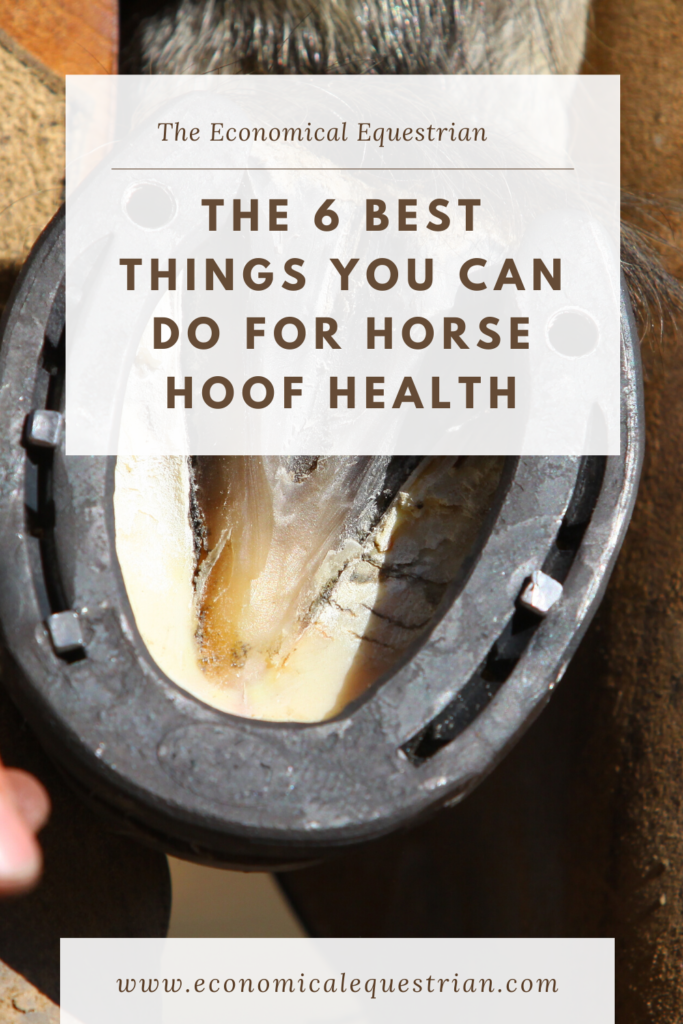
Have you ever heard the saying “no hoof, no horse”? Well there is a good reason for this saying. A horse’s hoof health is very important to their overall health. Taking care of your horse’s hooves should be of utmost priority.
Caring for your horse’s hooves involves multiple activities and work on your behalf.
Here are 6 things you should be doing to take care of your horse’s hooves:
Pick out your horse’s feet
Pick your horse’s feet as often as possible – whether it’s 1-2 times a day or 1-2 times a week. It is best to pick out a horse’s hooves before and after riding or once a day if you aren’t riding your horse.
The simple activity of picking out a horse’s feet can help hoof health in multiple ways. First, removing mud and poop from hooves helps prevent thrush. It also will help you find if there is any debris or damaging things wedged in a horse’s hoof. Horses can step on sharp objects, get rocks or sticks wedged in their hooves, or end up with cracks in their hooves.
Picking out a horse’s foot on a daily basis is extremely important and should not be overlooked even though it is a very basic part of horse care.
Apply thrush treatment as needed.
Thrush is a bacterial infection of a horse’s hoof. It is usually characterized by black or white “gunk” in the hoof and a stinky smell. Usually a thrushy frog has a deep central sulcus and a large crack up the back of the hoof.
Horses can experience pain in their hooves from a thrush infection, so it is important to treat it right away, and also to apply hoof treatment as a preventative measure against thrush.
There are many different products out there to cure and prevent thrush.
Here are the Top 10 Ways to Treat Thrush
Make sure you treat thrush as soon as you know there is an infection. Be diligent and then you can do occasional treatment to prevent it from coming back.
Feed your horse a balanced diet.
Most people do not realize how much of a role nutrition plays in their horse’s hooves. Nutrition can create a healthy hoof from the inside out.
I always suggest a horse vet or nutritionist if you need help determining your horse’s diet and supplements, because it is best to get a professional’s opinion. Mineral composition varies based on your geographic location and where you get your hay from, so testing your hay is very important for figuring out what your horse’s diet may be lacking.
Sometimes horses need a supplement to improve their hoof health, or they may need a whole diet overhaul.
Some of the most popular hoof supplements are:
Provide plenty of exercise for your horse.
Did you know that in the wild, horses will walk an average of 20-30 miles per day? How many miles do you think your horse walks in a day? If they live in a stall, the answer is likely far too little. Just riding your horse may not be enough exercise for a horse on a daily basis. If they have pasture turnout available, then they can give themselves a bit more exercise.
One nice way to get a horse walking and moving more through varied terrain is with a track system. A track system is basically a narrow path created through or around a pasture that allows your horse way more movement as well as varied terrain and feed options along the way. This book, titled Paddock Paradise, is a great intro to creating a track system (otherwise referred to as paddock paradise) for your horse.
Make sure your horse has somewhere dry to stand.
A horse should always have somewhere to go that is dry. Standing or being turned out is deep mud is harmful to a horse’s hooves and possibly the rest of their body as well. The dry area to stand also helps to prevent and treat thrush.
Provide regular farrier visits for your horse
Regular farrier visits are very important to your horse’s hoof health. Whether your horse is barefoot or in shoes, they need to have regular visits with a farrier or trimmer. Keeping a horse’s feet trimmed will help prevent hoof problems in the future as well. If a horse’s hoof is allowed to get too long, it could crack, split, flare, or have a separated white line. All of these things contribute to weaker hoof and could leave your horse in pain.
Depending on your horse’s hooves and the season, they should probably see a farrier every 4-8 weeks.
Are you taking good care of your horse’s hooves? If not, it is never too late to start! You owe it to your horse.
This blog has great information. So many people are unaware of thrush and other hoof problems and they can really make your horse miserable and possibly ruin them if left unchecked. Thank you for posting this and sharing this great information!